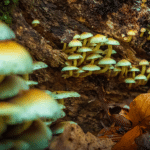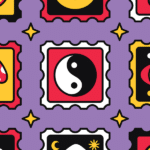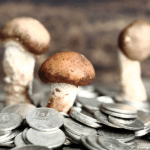Every year, ‘round the Holidays, I am reminded how the Internet is destroying our ability to think beyond what Google tells us to think. The message is repeated meme after meme, article after article, blog after blog – all recycling the same erroneous claim: namely, that the modern character of Santa Claus echoes psychedelic mushroom lore stemming from Siberian shamanism.
Since some (in reality, relatively few) Siberian medicine-workers consume the amanita muscaria fungus – the classic red fairytale mushroom speckled with white dots – it is imagined that Santa Claus somehow represents a modern incarnation of this mystical character from the colds of Mother Russia. The attempt to interpret the Santa saga as deriving from a mushroom-using Siberian shaman rests on the following four assumptions:
- The red and white colors of Santa’s outfit match the red and white colors of the amanita muscaria.
- Santa’s eight flying reindeer are based on Siberian reindeer that eat the amanita muscaria and get “high.”
- We place presents under an evergreen Christmas tree due to the mycorrhizal relationship (explained below) between evergreen trees and the amanita muscaria. The presents secretly represent the mushroom.
- We place mushrooms in stockings and hang them by the chimney with care because that’s how shamans dried their mushrooms.
It makes for a fun story. But all of this is wrong.
A Red (and White) Herring

While it is tempting to correlate the red and white colors of Santa’s costume with the mushroom, such associations are purely coincidental. During the 1800s, when Santa Claus was largely invented out of the earlier St. Nick, his costume went through a variety of changes. Americans didn’t think about Santa as having a standardized outfit. And as it turns out, red and white weren’t the only colors worn by Santa in America’s 19th century imagination. However, we do know where the red and white came from, and it has nothing to do with mushrooms. They came from the red, white, and blue of the American flag as shown on the cover of Harper’s Weekly in 1863, which depicts Santa clothed in patriotic garb.
This image appeared during the Civil War; Thomas Nast, the illustrator, was a staunch abolitionist and he drew St. Nick decked out in stars and stripes, giving provisions to Union soldiers. After the Civil War ended, St. Nick’s outfit again went through a variety of changes until 1931 when Coca-Cola adopted him (now rechristened “Santa Claus”) as their spokes-elf. Coca-Cola ads were already using red and white, and those colors were chosen for old St. Nick out of sheer convenience, not out of any affinity for the amanita muscaria.
If Santa’s costume colors really stemmed from the mushroom, then that “fact” would be evident right from the beginning. Instead, we see a natural, undirected cultural evolution that eventually lands on red and white for nothing more than advertisement purposes.
The Mushroom & the Reindeer
As for Santa’s flying reindeer, we encounter a similar issue — a steady evolution of character development. Like Santa’s wardrobe, his reindeer also have a cultural history that makes the supposed associations with Siberian reindeer quite unlikely. While Siberian reindeer do eat the amanita muscaria, which has intoxicating effects, it’s not the precursor for Santa’s flying reindeer. We know this because Santa’s vehicular flight predates any mention of reindeer.
The first U.S. mention we have of St. Nick with a flying vehicle is found in Washington Irving’s Knickerbocker History of New York (1809). In this book, St. Nick flies around not in a sleigh pulled by reindeer but in a wagon pulled by no animal at all. Later on, even after reindeer first enter the story, St. Nick is also said to have ridden a mule and a white horse — neither of which eat the amanita muscaria.
If the flying reindeer were true echoes of Siberian mushroom consumption (by human or animal), then that would be evident right out the gate. The flying reindeer would have to predate the flying wagon, but that’s not the case. And why are there other modes of travel, like horse or mule, if it’s really a story based on mushroom-eating reindeer?
Mushrooms Under the Tree
The amanita muscaria exists in a mycorrhizal relationship with certain conifer trees; this means that the mushroom grows out of the mycelia that form underground and colonize the roots of the tree. For this reason, it is said, we place presents under the Christmas tree — as an unwitting nod to the mushrooms that grow there. However, such an assumption is untenable for much the same reason all the other supposed connections fall short: namely, there is a traceable history that shows how we came to put presents under Christmas trees and, once again, it has nothing to do with mushrooms.
When modern Christmas traditions were first forming in the 19th century, trees weren’t associated with presents at all. At the time, Christmas stockings (and shoes) were the preferred gift-delivery system.1 Later, from the 1840s through the 1880s, Germanic people immigrated to the United States, bringing with them the Christmas tree. When Christmas trees first arrived during this period, they were hung from the ceiling.2
In the 1800s, houses were built with a single support beam running through the middle of the structure (you can still see this in old, colonial-style houses today). This sturdy plank allowed for celebrants to hang trees from the ceiling. And so for a while decorated trees could be seen hanging overhead. As the architecture in modern houses changed, and plaster ceilings replaced those supported by the long-beam, Christmas trees found a new home on tables. But they still had no association with presents — there was no expectation of finding a gift left by Santa next to a Christmas conifer.
In the most famous poem ever composed about Christmas, “A Visit from St. Nick” (1823), Clement Clarke Moore writes, “the stockings were hung by the chimney with care, in hopes that St. Nicholas soon would be there.” Odd as it may sound, a Christmas tree is not mentioned once in this most culturally significant poem about Christmas. It wasn’t until the mid-1800s that people started to associate Christmas trees with Christmas gifts. However, they still didn’t place gifts under the tree. In those days, gifts were typically small figurines and candies that hung on the branches of the tree alongside other decorations.

Again “A Visit from St. Nick,” gives us insight. In the poem, while the children slept, they do not dream of bicycles and dollhouses, but rather simple items like “sugar plums,” visions of which “dance in their heads.” With the rise of corporate capitalism in the late 1800s, the presents grew in size. What was once a modest array of sweets and nuts and small knick-knacks had now become hobbyhorses, dollhouses, and music boxes. Being too large and weighty, they could no longer find real estate on the branches of the tree — and so they were placed beneath it.
Again, we encounter a familiar problem. If placing presents under the Christmas tree had anything to do with the amanita muscaria fruiting mutualistically under evergreen trees, then placing presents under the tree should have been the first, not the last to catch on as a Christmas custom. Instead we see the natural unfolding amalgam of a cultural trend, spurred on by Germans (not Siberians), beginning with the Christmas stocking and trees hung from the ceiling; to small trees placed on tables without gifts; then to hanging small gifts on the Christmas tree branches; and ending with the modern custom of placing gifts beneath the tree. Where exactly does the mushroom fit into any of this?
Stockings Hung by the Chimney with Care
The last claim about psychedelic Santa holds that we originally used stockings as the gift carrier because that’s how Siberian shamans dried their mushrooms — by hanging them (like we hang socks stuffed with gifts). This is an easy one to debunk.
Unlike the other aspects of the modern Santa myth which unfolded over time, we can trace the origin of putting presents in stockings to one medieval story about St. Nick. It was said that Nicklaus had heard of a widower who could not afford dowries for his three daughters. Nick, a man who legend holds was born into wealth, threw gold coins through the man’s window as dowry for his first daughter. Another night, Nicklaus threw more coins through the window as dowry for the second daughter. When Nicklaus returned for the last time to throw coins through the window for the third daughter, a few coins got caught in a stocking that she was drying beside the chimney. That, not mushrooms, is where the tradition originates.
Historical IRONY
It’s noteworthy – and ironic – that the Siberian shaman version of Santa Claus is completely absent from popular Russian lore about their mythic Midwinter figure, Ded Moroz (Grandfather Frost), who is accompanied by Snegurochka (the Snow Maiden). Incidentally, Ded Moroz and Snegurochka travel in a sled pulled not by flying reindeer, but instead by terrestrial horses. The supposed association between Siberian reindeer and Santa’s reindeer is specifically an American invention — contemporary Russians have largely never even heard of it any more than Americans have heard of Ded Moroz and Snegurochka.

There are other ironies as well. The Siberian shaman entered popular Western culture in the late 1700s. Many books, paintings, and mycology guides — all featuring the amanita muscaria mushroom — were produced during the 1800s, when our modern ideas about Santa Claus first developed.3 The two cultural figures (the Siberian shaman and Santa Claus) both entered Western popular culture around the same time, and yet they never overlapped!
Throughout the 1800s, no one who wrote about St. Nick (as he was transforming into Santa Claus) associated him with shamanism or the mushroom. Likewise, no one who wrote about the amanita muscaria and various Siberian cultures ever said anything about Santa Claus or St. Nick. You simply cannot find this in the literature – even at a time when “drugs” did not have the social taboo they have today.4
So, How Did it Begin?
So, when and how did the story of the “shaman Santa” originate? It does not come from the deep abysses of history but can be traced quite accurately to the 20th century. The first person to ruminate on this supposed connection was Robert Graves in his (appropriately titled) Difficult Questions, Easy Answers (1972). But he offered no evidence for his claim.
The idea passed around largely unnoticed from Graves to ethnobotanist Jonathan Ott in the late 1970s. The first full length book, however, to discuss the possible connection between Santa Claus and the shaman was Tony van Renterghem’s When Santa was a Shaman (1995). Interestingly, van Renterghem does not cite any reliable sources to back up his claim. Apparently (based on his bibliography) he wasn’t even aware or saw no use for either Graves or Ott’s ideas. And he makes no connection between Santa Claus and the amanita muscaria.
In fact, Renterghem says nothing about mushrooms at all — in any context. Indeed, it almost sounds like he purposefully skips over them when addressing “shamanic” techniques: “sound, music, dancing, mimicry, masks, make-up, costumes, and art, as well as fire, sex, and violence …”5 But no mushrooms. For Renterghem, the “shamanic” association with reindeer comes from an ancient “symbolic fertility ritual … to magically increase the growth of the herd.”
Psychedelic mushrooms were not part of the ceremony.6
The first substantial writing to tie Santa to the mushroom came in 2007, with Patrick Harding’s The Christmas Book (2007). Unfortunately, like van Renterghem before him, Harding offers zero actual evidence to back up his claims. He leaves us questioning where he got these ideas. The answer is quite simple: he made them all up.
In Sum
This critique is less about the bogus connection between Siberian mushroom-eating shaman and Santa Claus and more about the flippant way information is shared in the modern age. Virtually every relevant article, YouTube video, and internet blog on this topic will trumpet the psychedelic Xmas fable as if they weren’t just plagiarizing each other. Aside from the lack of originality, this copy-cat phenomenon underscores how we are slipping steadily into a post-fact world where celebrities, “influencers,” pseudo-journalists, and clickbait cravers can bandy uninformed claims about the nature of the world and historical realities to a gullible audience. In the process, we are losing our ability to think critically about anything.
We have replaced honest inquiry with information-fishing in the oceans of our own echo chambers. We buy into fables about Santa Claus and magic mushrooms for the same reason a conspiracy theory gets traction. It allows us to feel like we have some kind of privileged knowledge about the world and reinforces what we are already inclined to believe.
Thomas Hatsis is the author of several books, including The Witches’ Ointment and LSD The Wonder Child: The Golden Age of Psychedelic Research in the 1950s. © Copyright, Project CBD. May not be reprinted without permission.
Sources
- Bruce David Forbes, Christmas: A Candid History (CA: University of California Press), 52.
- Benjamin A. Smith (trans.) Bernd Brunner, Inventing the Christmas Tree (CT: Yale University Press, 2012), 40.
- See Andy Letcher Shroom: A Cultural History of the Magic Mushroom (2007), 122-29.
- Ibid. Despite the plethora of first-hand account drug literature in the 19th century (for example, Fitz Hugh Ludlow, The Hasheesh Eater,1857); Thomas De Quincy, Confessions of an English Opium Eater, 1821), all the stories about the amanita muscaria were fictitious accounts, notwithstanding those few coming from actual Siberian shamans.
- Tony van Renterghem, When Santa was a Shaman (MN: Llewellyn Publications, 1995), 57.
- Ibid., 63.
Recommended Readings
LSD Therapy for Alcoholism
Excerpted from “LSD ― The Wonder Child: The Golden Age of Psychedelic Research in the 1950s” by Thomas Hatsis.
Doctor Sues DEA for Right to Give Psilocybin to Ailing Patients
Magic mushroom extract has been fast-tracked by the FDA for depression, but doctors still can’t use it in their practice.









